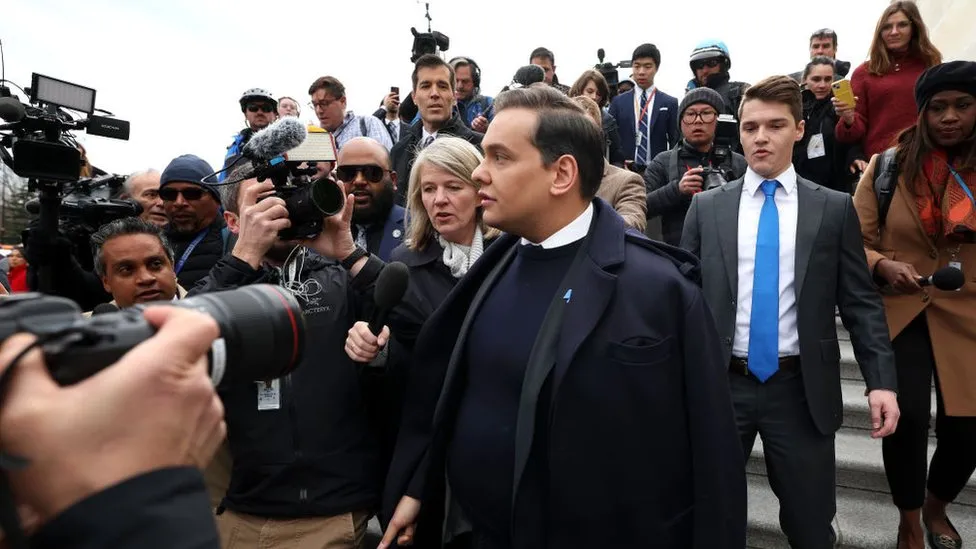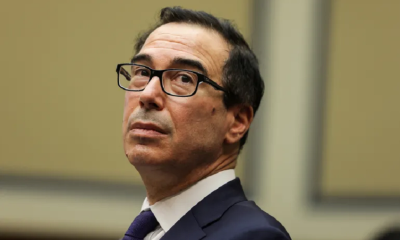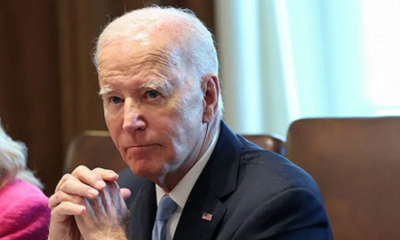Foreign News
US House votes to expel George Santos from Congress

After a damning ethics report, fraud charges and lies about his past, the US House of Representatives has expelled Congressman George Santos.
Lawmakers voted 311 to 114 to oust the disgraced lawmaker.
He has been accused of using campaign money for luxury expenses such as Botox and stealing charity money for a veteran’s dying service dog. The 35-year-old from Queens is only the sixth lawmaker in history to be expelled from Congress.
His ouster comes after the House ethics committee released a report that found he “blatantly stole from his campaign” and exploited “every aspect of his House candidacy for his own personal financial profit”.
Among the many allegations in its final report, the panel accused him of spending campaign money on OnlyFans – a platform where users pay for content, including pornography – and holidays in the Hamptons, an elite seaside enclave in New York state.
Expulsion votes are rare in Congress and require a two-thirds super majority.
Santos made a quick exit as the votes against him started to pour in, jumping straight into a waiting SUV without answering any questions. After the resolution to expel Santos was adopted on Friday, there was scattered applause from both sides of the aisle.
A group of four New York Republicans who were elected alongside George Santos and who have long sought to give him the boot said they can now finally “stop talking about him”. They also dispute it sets bad precedent to remove him.
“The precedent that is set is that we hold members of Congress to a higher standard,” said New York Republican lawmaker Anthony D’Esposito. “The people of New York’s third congressional district need representation.” D’Esposito added that “it shouldn’t have come to this”.”He should have held himself accountable. He should have resigned,” he said.
Others, however, have defended Santos. Republican congresswoman Marjorie Taylor Greene called the vote “shameful”, adding that it will erode the Republican majority in the House.
Santos faces troubles outside of Washington DC as well. The 35-year-old has been charged with 23 federal felony counts, including wire fraud, money laundering and theft of public funds, as well as separate allegations of campaign finance violations.
His trouble started shortly after winning an election in November 2022 to represent New York’s 3rd congressional district. The New York Times published an investigation in December that revealed Santos had lied about a Wall Street career, a college degree and having Jewish ancestry. Since then, allegations against the lawmaker have continued to pile up. He has been accused of a range of fabrications and fraud schemes, including scamming Amish dog breeders in Pennsylvania and claiming his mother died in the 9/11 terror attacks.
The scandals swirling around the lawmaker have pulled off the rare feat of uniting lawmakers on both sides of the aisle as they came together to have him removed. Santos had remained defiant, refusing to resign despite many calls from both sides of the aisle to step down.
“This place is run on hypocrisy,” he told reporters earlier this week. “If they want me to leave Congress, they’re going to have to take that tough vote.”
Santos has said he would leave the Capitol right away if expelled.
New York Governor Kathy Hochul has 10 days to call for an election, which would take place 70 to 80 days later.
The ouster and special election could further pare down Republicans’ narrow nine-seat House majority. There is no guarantee another Republican will win the congressional seat he holds, which was easily won by Joe Biden in the 2020 general election.
Santos loses the ability to vote on legislation immediately. Workers will also quickly remove his nameplate from his office in the Longworth building across the street from the Capitol. In the meanwhile, House clerk staff will continue running daily operations for the district until Santos’ replacement is elected. Santos will also lose his health insurance, the officials said.
He can still dine, however, in the exclusive House restaurant, exercise in Capitol gym and borrow books from the Library of Congress – all privileges afforded to former members of Congress.
But he is not eligible for a congressional legislative pension.
Foreign News
Nasa ‘Earthrise’ astronaut dies at 90 in plane crash

Apollo 8 astronaut Bill Anders, who snapped one of the most famous photographs taken in outer space, has died at the age of 90.
Officials say a small plane he was flying crashed into the water north of Seattle, Washington.
Anders’ son Greg confirmed that his father was flying the small plane, and that his body was recovered on Friday afternoon. “The family is devastated. He was a great pilot. He will be missed,” a statement from the family reads.
Anders – who was a lunar module pilot on the Apollo 8 mission – took the iconic Earthrise photograph, one of the most memorable and inspirational images of Earth from space.
Taken on Christmas Eve during the 1968 mission, the first crewed space flight to leave Earth and reach the Moon, the picture shows the planet rising above the horizon from the barren lunar surface.
Anders later described it as his most significant contribution to the space programme.

The image is widely credited with motivating the global environmental movement and leading to the creation of Earth Day, an annual event to promote activism and awareness of caring for the planet.
Speaking of the moment, Anders said: “We came all this way to explore the Moon, and the most important thing that we discovered was the Earth.”
Officials said on Friday that Anders crashed his plane around 11:40PDT (1940BST).
The US National Transportation Safety Board (NTSB) said the 90-year-old was flying a Beechcraft A A 45 – also known as a T-34. The agency said that the plane crashed about 80ft (25m) from the coast of Jones Island.
Anders also served as the backup pilot to the Apollo 11 mission, the name of the effort that led to the first Moon landing on July 24, 1969.
Following Anders’ retirement from the space programme in 1969, the former astronaut largely worked in the aerospace industry for several decades. He also served as US Ambassador to Norway for a year in the 1970s.
But he is best remembered for the Apollo 8 mission and the iconic photograph he took from space.
“In 1968, during Apollo 8, Bill Anders offered to humanity among the deepest of gifts an astronaut can give. He traveled to the threshold of the Moon and helped all of us see something else: ourselves,” Nasa Administrator Bill Nelson said in a statement.
Mark Kelly, a former astronaut who now serves as a US Senator for the state of Arizona, said in a post on X, formerly Twitter, that Anders “inspired me and generations of astronauts and explorers. My thoughts are with his family and friends”.
[BBC]
Foreign News
China’s Chang’e-6 lifts off from far side of Moon with rock samples

A Chinese spacecraft carrying rock and soil samples from the far side of the Moon has lifted off from the lunar surface to start its journey back to Earth, according to state media.
The achievement on Tuesday is a world first and the latest leap for Beijing’s decades-old space programme, which aims to send a crewed mission to the Moon by 2030.
The Xinhua News Agency, citing the China National Space Administration (CNSA), said that the ascender of the Chang’e-6 probe took off at 7:38am local time on Tuesday (23:38 GMT) and entered a preset orbit around the moon.
It described the move as “an unprecedented feat in human lunar exploration history”.
The Chang’e-6 probe was launched last month and its lander touched down on the far side of the Moon on Sunday. It used a drill and robotic arm to dig up soil on and below the Moon’s surface, according to Xinhua.
After successfully gathering its samples, the Chang’e-6 unfurled China’s national flag for the first time on the far side of the Moon, it said.
The agency cited the CNSA as saying that the spacecraft stowed the samples it had gathered in a container inside the ascender of the probe as planned.
[Aljazeera]
Foreign News
China says its spacecraft lands on Moon’s far side

China says its uncrewed craft has successfully landed on the far side of the Moon – an unexplored place almost no-one tries to go.
The Chang’e 6 touched down in the South Pole-Aitken Basin at 06:23 Beijing time on Sunday morning (22:23 GMT Saturday), the China National Space Administration (CNSA) said.
Launched on 3 May, the mission aims to collect precious rock and soil from this region for the first time in history. The probe could extract some of the Moon’s oldest rocks from a huge crater on its South Pole.
The landing was fraught with risks, because it is very difficult to communicate with spacecraft once they reach the far side of the Moon. China is the only country to have achieved the feat before, landing its Chang’e-4 in 2019.
After launching from Wenchang Space Launch Center, the Chang’e 6 spacecraft had been orbiting the Moon waiting to land. The lander component of the mission then separated from the orbiter to touch down on the side of the Moon that faces permanently away from Earth.
During the descent, an autonomous visual obstacle avoidance system was used to automatically detect obstacles, with a visible light camera selecting a comparatively safe landing area based on the brightness and darkness of the lunar surface, the CNSA was quoted as saying by state-run Xinhua news agency.
The lander hovered about 100m (328ft) above the safe landing area, and used a laser 3D scanner before a slow vertical descent. The operation was supported by the Queqiao-2 relay satellite, the CNSA said.
Chinese state media described the successful landing as an “historic moment”. The state broadcaster said “applause erupted at the Beijing Aerospace Flight Control Center” when the Chang’e landing craft touched down on the Moon early on Sunday morning.
The lander should spend up to three days gathering materials from the surface in an operation the CNSA said would involve “many engineering innovations, high risks and great difficulty”. “Everyone is very excited that we might get a look at these rocks no-one has ever seen before,” explains Professor John Pernet-Fisher, who specialises in lunar geology at the University of Manchester.
He has analysed other lunar rock brought back on the American Apollo mission and previous Chinese missions. But he says the chance to analyse rock from a completely different area of the Moon could answer fundamental questions about how planets form.
Most of the rocks collected so far are volcanic, similar to what we might find in Iceland or Hawaii. But the material on the far side would have a different chemistry . “It would help us answer those really big questions, like how are planets formed, why do crusts form, what is the origin of water in the solar system?” the professor says.
The mission aims to collect about 2kg (4.4lb) of material using a drill and mechanical arm, according to the CNSA.
The South Pole–Aitken basin, an impact crater, is one of the largest known in the solar system.
From there, the probe could gather material that came from deep inside the lunar mantle – the inner core of the Moon – Prof Pernet-Fisher says.
The Moon’s South Pole is the next frontier in lunar missions – countries are keen to understand the region because there is a good chance it has ice.

The capsule in the last Chinese moon mission, Chang’e 5, brought back soil and rocks in 2020 (BBC)
Access to water would significantly boost the chances of successfully establishing a human base on the Moon for scientific research.
If the mission succeeds, the craft will return to Earth with the precious samples on board a special return capsule.
The material will be kept in special conditions to try to keep it as pristine as possible.
Scientists in China will be given the first chance to analyse the rocks, and later researchers around the world will be able to apply for the opportunity too.
This is the second time China has launched a mission to collect samples from the Moon.
In 2020 Chang’e 5 brought back 1.7kg of material from an area called Oceanus Procellarum on the Moon’s near side.
China is planning three more uncrewed missions this decade as it looks for water on the Moon and investigates setting up a permanent base there.
Beijing’s broader strategy aims to see a Chinese astronaut walk on the moon by around 2030.
The US also aims to put astronauts back on the moon, with Nasa aiming to launch its Artemis 3 mission in 2026.
(BBC)




















